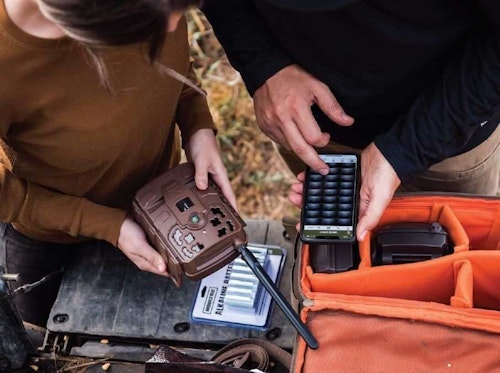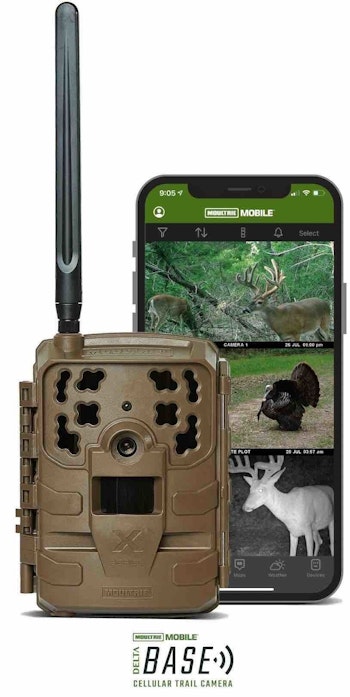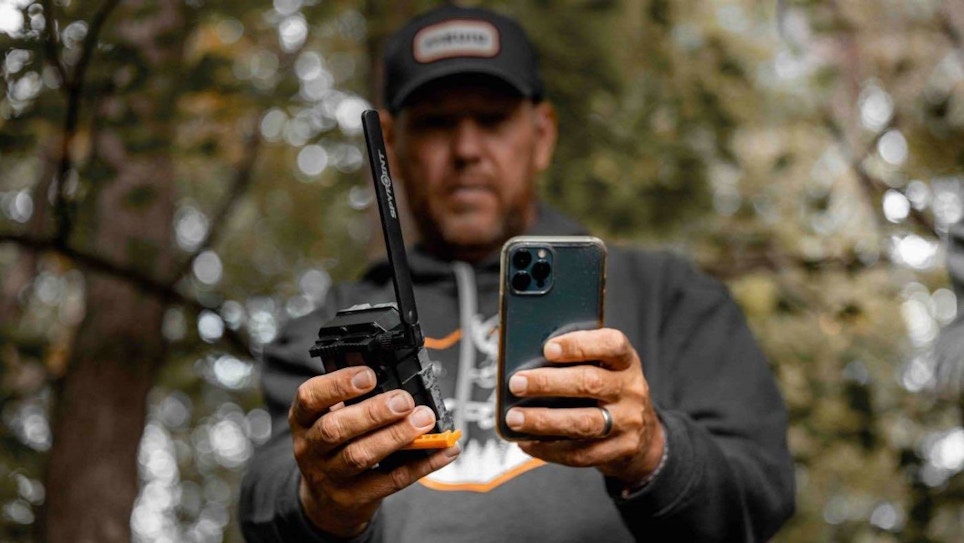
Selling the right trail cam is about assessing a customer’s personal needs, then recommending a camera with features and settings to address those things.
Trail cameras have revolutionized the way we hunt. They improve scouting efficiency, reveal what properties have to offer, help manage age structure of the whitetail herd, aid in treestand location selection, and much more. Today’s trail cams have incredible features and settings that offer unparalleled value, especially if used correctly. Here are descriptions of some of those, with input from SpyPoint’s Trent Marsh and Cuddeback’s Dan Schultz and Jared Peterson.
Info Strip
The most important aspect of a trail camera, and the biggest value it offers, is something all cameras have — the info strip (time/date stamp). Given all the things the modern trail camera can do, it’s one of the earliest features that benefit hunters the most. The simple concept of being able to capture an image of a deer, determine which one it is, know if it was there during daylight, on what day, and at what time, is powerful information.
Trigger Speed
Moving on to the features you really want to discuss with customers, trigger speed is at the top of the list. Looking over the entire market, most cameras range from 0.2- to 1-second triggers. The former is blazing fast, while the latter is relatively slow.
“The faster trigger speeds are harder to do,” Peterson said. “Most people want multiple pictures of that animal. So, you need a quick detection to get multiple shots. So, there is a fair amount of technology that goes into this. It doesn’t do much good if a buck’s head is out of the frame.”
Oftentimes, it’s OK to have a slower trigger speed, depending on how you’re using the camera, though. For example, those who are posting cameras over a bait pile, mineral lick, food plot, watering hole, or anything else that slows down deer movement, will generally be OK with a slower trigger speed. However, cameras that are posted along trails or anywhere or anytime deer might move faster — such as during the rut — are better off with a faster trigger speed.
“Trigger speed is tricky,” Marsh said. “Faster is better, but only to a point. A lot of people are confused about what exactly it is. Trigger speed is the time it takes for the camera to wake up from sleep mode and capture a photo. During that time, the camera must take stock of the ambient conditions to determine camera settings for the best photo. The longer a camera must do this, the better the photo will be. But at some point, if it’s too slow, then the animal that triggered it could have moved on. I really like anything in that 0.3- to 0.5-second range. At that point, the camera should be able to gauge conditions well, but still move quickly enough to capture the photo.”
Detection Ranges
Another important feature for trail cam customers to understand is detection range, meaning how close an object must be to trigger the detection sensor on a cam. “I want to cover as big an area as possible, as efficiently as possible,” Marsh said. “The combination of a solid trigger time and detection range can ensure that the camera is up and taking photos to get me the information I need.”
Typical detection ranges vary from 50- to 100-plus feet. These are generally more restricted at night. Also, common field of view is 35 to 40 degrees. That said, how hunters deploy cameras can factor into detection range, too. If you point the camera too high or low, it’s not going to detect well.
Flash Ranges
Not to be confused with detection range, the flash range is the distance at which the incorporated illumination method can light up the low-light or nighttime landscape. Generally, the detection ranges and flash ranges are close to the same, but not always exactly.
Illumination
Selecting the right trail camera involves analyzing nighttime illumination methods. If it’s a nighttime picture, you need it to show detail without blur. Of course, daytime photos can be impacted by lighting, too. Cameras that address these things in a better and more efficient way might be superior to those that don’t.
“Every method has its advocates and detractors,” Marsh said. “Some guys love white flash. Other say it spooks deer. Same with low-glow IR. Even the invisible or dark illumination has people who say the animals notice it. For me, the best balance of value and disturbance is the low glow. Dark or invisible flash is nice, but I think good camera positioning with a low-glow camera is just as concealed.”
Still worried about spooking deer? Some hunters get big whitetails on flash cameras consistently, in and out of the rut. But the deer’s personality might impact whether white flash bothers them or not.
“White flash gets you the best nighttime picture,” said the Cuddeback representatives. “But the most popular flash is the IR, which is lower than the white flash, but it’s better than black flash.”
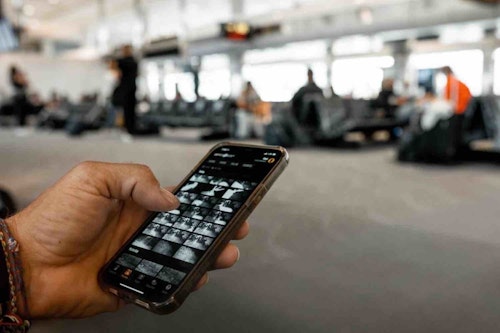
Megapixels
This is a trail cam concept that’s vastly overrated and not fully understood. Some hunters think the higher the megapixels the better, and that’s true if you want very crisp photos. But even then, it isn’t always what it seems.
“Megapixels are less important than oftentimes projected,” Schultz said. “Cameras with 20- and 30-plus megapixels [generally] aren’t really that high. Interpolation is a mathematical equation that takes the photo and gives it more detail, but it’s not a true representation of the photo.”
“It gets a lot of hype that is a little overstated,” Marsh said. “Sure, the more MP the more detail, but I’m not blowing these pics up to hang on the mantle. I don’t need 50 MP to decide if a buck is a shooter.”
For those who just want photos of deer that are sharp enough to determine unique bucks, just about any cam can do that.
Multi-Shot
Cameras that offer a multi-shot or multi-burst mode can do things that single-shooting modes cannot. “Maybe I have a doe being chased by a buck,” Peterson said. “With multi-shot, it allows me to catch the buck behind the doe. It’s like everything — there are times when it wouldn’t matter. And there are scenarios where you’d miss a deer without it.”
“This kind of dovetails with trigger speed and detection zone,” Marsh said. “Multi-shot gives you the best chance to get the animal at different angles. But know where your camera is. Multi-shot is a must on a trail, but on a feeder or mineral site where the deer is likely to linger, one photo every 15 or 30 seconds is probably fine.”
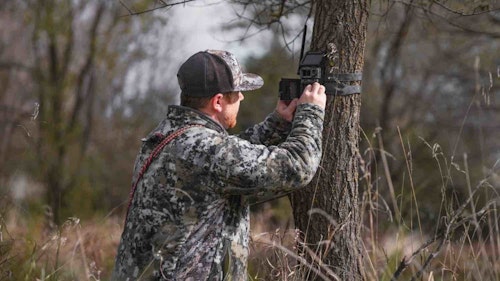
Time Lapse
While most scenarios are better suited with a triggered photo capture, some are better off with a time lapse mode. Unfortunately, not all cameras offer this. Still, for those that do, time lapse allows you to take photos without heat or motion. If the camera can take a picture every so often, that’s an advantage when wanting to see every deer that’s feeding on a small food plot. This mode is also very good for capturing deer pics at greater distances on larger fields.
Aspect Ratio
The aspect ratio of a photo is different from camera to camera. Some ratios offer a shorter height and wider width, or vice versa. Overall, if you’re worried more about the top and bottom of the photo, use a full aspect ratio. If you want more room left and right, the wider aspect ratio is better.
Cellular Capability
The latest and most popular feature incorporated with trail cameras, cellular capabilities allow hunters to check cameras remotely and without going afield. This too is very beneficial for decreasing the amount of pressure you apply to area whitetails, but only if the cellular camera offers long battery life.
“Nothing is more valuable than my time,” Marsh said. “If I can spend more time with my family, rather than going to the woods, and burning $4 gas, the happier I am. I’m also impatient. I don’t want to wait two weeks to see photos. I want to see what happened today, today. It lets me evolve my hunting plan over time.
“It’s no magic bullet though. Two years ago, we got about 100 daylight photos of a 190-200-inch deer that we never got a look at. Cellular is great. It lets you hunt all day every day by keeping tabs on your property but using cellular doesn’t come close to moving the advantage to the hunter.”
Overall, cellular cameras that offer longer battery life solve problems. These include not educating deer, cheaper trail camera checks (less gas burned), faster trail camera checks (less time invested), and more.
“Cellular is continuing to grow,” Peterson said. “There’s a lot about it that makes sense. One, people like the immediacy of it. But you have all these states making rules about cameras, and companies might be forced to put delays in these cameras. But even if the government demands a delay, it’s still more convenient than using traditional cameras.”
Final Thoughts
Trail cameras are highly effective scouting tools that offer countless advantages. They help take inventory, monitor herd health, pattern deer, and convey how deer use and traverse the areas you hunt.
Cameras also help with other more nuanced objectives, too, such as signaling rut activity, monitoring properties, and timing the antler drop for shed hunting. The smart use of trail cams can help your customers be more successful in the field, and they’re just plain fun to use.
Sidebar: Battery Life
Different trail camera companies focus on different battery platforms. Some focus on AAs, Cs, or Ds. Others are more focused on battery packs, solar panels, and other options. Overall, that doesn’t quite matter as much as how efficient the camera is with the selected platform.
“The bigger the battery, the more power,” Cuddeback’s Dan Schultz said. “One D is equivalent to several AAs. We aren’t going to say companies can’t build on the AA platform. But for us, the D platform works well.”
Different types of batteries make a difference, too. It’s also important to analyze alkaline vs. lithium. Determine which is better for your situation. But remember, some cameras can or can’t run on lithium, and many of those that do, have internal settings that need adjusting.
“Lithium rechargeable packs for the specific camera are going to be the very best option,” SpyPoint’s Trent Marsh said. “Premium brand lithium or alkaline AA batteries have come a long way, though. The main thing is to use good brands. And when using lithium, remember, the discharge curve is steep. Once they start to go, they go fast. When running lithium batteries, and it shows 50%, they are probably dead already.”
Sidebar: Remote Scouting in the Palm of Your Hand
By Bowhunting World Staff
Cellular trail cams can do what traditional trail cams can’t — send real-time intel from the woods to your location, no matter the distance to your camera. All of this is done via cellular connectivity and an app on your smart phone.
“The cell camera is the hardware that takes the photo and sends it via cellular signal to a cloud-based server,” said Mark Olis, content marketing manager for Moultrie Mobile. “Once the image is uploaded to the cloud, the real magic happens inside the app.”
Image Storage and Management
The app stores all your images in a gallery, where they can be viewed 24/7. After an image is uploaded to the Moultrie Mobile app, it lives there forever. Images aren’t deleted unless the customer deletes them.
Trail cam images are uploaded based on the time interval the user selects for their camera. That can range from immediate uploads, to once per day, or various intervals in between. These upload intervals can be changed whenever and wherever from your app.
Remote Settings
A cellular trail cam gives the user the freedom to change all their camera settings anytime, anywhere through the app. There’s no need to physically go to the camera to do this.
Advanced Scouting Features
The Moultrie Mobile app has advanced technology that helps hunters learn more about game. Here’s a brief rundown of this tech.
- Species Recognition: Uses artificial intelligence to automatically scan all your images for buck, doe, turkey, hog, coyote, bobcat, bear, and even people and vehicles. This allows you to click on the Smart Tag function to quickly see buck images only, or turkey, or hog, etc. This allows you to skip the raccoon and doe images if you’re not interested in seeing those.
- Notifications: Inside the Moultrie Mobile app you can set up phone notifications for individual cameras to alert you when a specific species is indicated in an image. This allows you to get alerts when a buck, coyote, hog or turkey shows up on camera. The system can also be used for security at remote properties and send you an immediate alert if a person or vehicle shows up on camera. This allows you to contact local authorities that someone is trespassing.
- Activity Charting: Each images contains data with it, such as time, temperature and moon phase. Moultrie Mobile’s Activity Charting automatically pulls this data into easy-to-view graphs to show you when and where peak game movements are happening. With selectable date ranges, you can see when game is moving the most based on time, temp and moon phase. You can also use the Smart Tags by species to find the peak movements for bucks, turkeys, hogs, etc.
- Weather: The weather feature on the app gives hourly, daily and weekly weather forecasts for your hunting area. There’s no need to open another app to learn wind direction and speed. Plus, sunrise and sunset are clearly marked on the hourly forecast so you can quickly determine your legal shooting times.
- Interactive Maps: With street map and satellite views, you can map out your hunting areas. There are more than 20 scouting pins for camera locations, bedding areas, rubs, scrapes, food plots, treestands, gates and even blood-trailing pins. Combining this information with game movement on your cameras allows you to see the big picture of how to best hunt your area.
“Cellular trails cameras allow hunters to keep up with game movement on their hunting property, without stepping foot on it and disturbing animals in the area,” said Olis. “Now the weekend warrior can head to hunt camp on a Friday night and know exactly where he wants to sit on Saturday morning.”
The Moultrie Mobile app is free to download and there’s no upcharges for any of the advanced features mentioned. You can even download the app from the App Store or Google Play and try a full demo version with all the features mentioned previously.
Note: Users will have to sign up for a data plan. Visit www.moultriemobile.com/plans/ to learn more. In general, plans range from $4.99 per month (100 images plus 1 video upload per month; one camera) to $9.99 per month (1,000 images plus 10 video uploads per month; one camera) to $16.99 per month (unlimited images plus 50 video uploads per month; one camera). There’s also a multi-camera unlimited plan that starts at $34.99 per month with each additional camera added for $7.99 per month (unlimited images plus 50 video uploads per month; per camera). This plan saves money per camera when running four or more cameras. There’s no contract, no activation or cancellation fees; you can sign up monthly, or save even more with an annual plan, and cancel the data plan at any time.


